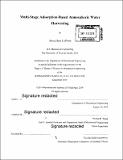| dc.contributor.advisor | Evelyn N. Wang. | en_US |
| dc.contributor.author | LaPotin, Alina Dale. | en_US |
| dc.contributor.other | Massachusetts Institute of Technology. Department of Mechanical Engineering. | en_US |
| dc.date.accessioned | 2020-11-03T20:31:38Z | |
| dc.date.available | 2020-11-03T20:31:38Z | |
| dc.date.copyright | 2019 | en_US |
| dc.date.issued | 2019 | en_US |
| dc.identifier.uri | https://hdl.handle.net/1721.1/128337 | |
| dc.description | Thesis: S.M., Massachusetts Institute of Technology, Department of Mechanical Engineering, September, 2019 | en_US |
| dc.description | Cataloged from PDF version of thesis. | en_US |
| dc.description | Includes bibliographical references (pages 69-72). | en_US |
| dc.description.abstract | Atmospheric water harvesting (AWH) is the capture and collection of water that is present in the air either as vapor or small water droplets. Adsorption-based AWH uses adsorbent materials to collect water vapor from the air, the advantage being that the adsorbents can be regenerated by low-grade thermal sources, and condensation can occur at ambient temperatures. It has the potential to be more widely applicable to areas which are facing water scarcity because it can operate in areas with consistently low relative humidity (RH), where traditional approaches such as dewing and fog harvesting aren't feasible. Previous work in this area has demonstrated AWH driven by direct solar heating in low RH conditions (10 - 40%). However, water harvesting productivity, LMD (liters of water harvested per square meter solar receiver area per day), of these devices is limited by vapor transport in packed adsorbent layers, which severely limits adsorbent layer thickness. | en_US |
| dc.description.abstract | Additionally, the heat flux which must be rejected at the condenser is significant and consists of both heat conducted through the device and the latent heat of condensation. In this thesis, we present a new configuration for a solar-thermal adsorption-based AWH device which uses two stages (TS-AWH) to increase the LMD over single-stage devices. The TS-AWH device uses the latent heat of condensation from the top stage as well as a temperature gradient between the stages to drive desorption of the bottom stage. This configuration provides greater utilization of the solar energy received at the absorber, recycling of the latent heat, and takes full advantage of the temperature difference between the solar absorber and the condenser. We present our framework for modeling heat and mass transport in adsorbent layers and use this model to design layers which can be incorporated in AWH systems for passive operation on a daily cycle. | en_US |
| dc.description.abstract | We developed a model of the TS-AWH system which predicts that both layers can be desorbed under unconcentrated sunlight. We used AQSOA zeolites ZO1 and Z02 for the adsorbents and our characterizations showed that they exhibit favorable properties for AWH, including fast intracrystalline kinetics. Based on insight gained from parametric studies of the effect of geometric parameters on LMD, we built and tested a prototype using ZO1 in outdoor water harvesting experiments on the MIT roof, where we showed solar-driven regeneration using unconcentrated sunlight. We demonstrated the validity of the TS-AWH concept by achieving a higher LMD than the maximum performance of a single-stage device, showing the promise of using TS-AWH to increase the performance of solar-thermal adsorption-based AWH systems. Our device demonstrates progress towards scaling up solar-thermal AWHs, as we harvested 80x more water than our previous device under similar, unconcentrated solar flux conditions. | en_US |
| dc.description.statementofresponsibility | by Alina Dale LaPotin. | en_US |
| dc.format.extent | 72 pages | en_US |
| dc.language.iso | eng | en_US |
| dc.publisher | Massachusetts Institute of Technology | en_US |
| dc.rights | MIT theses may be protected by copyright. Please reuse MIT thesis content according to the MIT Libraries Permissions Policy, which is available through the URL provided. | en_US |
| dc.rights.uri | http://dspace.mit.edu/handle/1721.1/7582 | en_US |
| dc.subject | Mechanical Engineering. | en_US |
| dc.title | Multi-stage adsorption-based atmospheric water harvesting | en_US |
| dc.title.alternative | Multi-stage adsorption-based AWH | en_US |
| dc.type | Thesis | en_US |
| dc.description.degree | S.M. | en_US |
| dc.contributor.department | Massachusetts Institute of Technology. Department of Mechanical Engineering | en_US |
| dc.identifier.oclc | 1201697448 | en_US |
| dc.description.collection | S.M. Massachusetts Institute of Technology, Department of Mechanical Engineering | en_US |
| dspace.imported | 2020-11-03T20:31:37Z | en_US |
| mit.thesis.degree | Master | en_US |
| mit.thesis.department | MechE | en_US |
